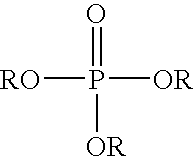Molding compositions containing polyalkylene terephthalates and modified polybutylene terephthalate (PBT) random copolymers derived from pet
a technology of polyalkylene terephthalate and polybutylene terephthalate, which is applied in the field of molding compositions containing polyalkylene terephthalates and modified polybutylene terephthalates (pbt) random copolymers derived from pet, can solve the problems of document not meeting the long-held need of improved use, the amount of co2 emissions, and the inability to recycle sources of pbt-polyalkylen
- Summary
- Abstract
- Description
- Claims
- Application Information
AI Technical Summary
Benefits of technology
Problems solved by technology
Method used
Image
Examples
example 3 and example 4
Comparative
[0171] Purpose—The objective of these experiments was to prove that useful molding composition containing PET derived PBT, PET and glass can be made. Also, the molding composition containing the PET derived PBT is more energy efficient than its equivalent containing DMT derived PBT.
[0172] The compositions of examples 3 and 4 are shown in Table 5.
TABLE 5‘PET derived PBT’ Composition containing PET and glass4Item DescriptionUnit3(Comparative)GE PBT 315, 1.2 iv%9PET Derived PBT, 1.2 iv%9GE PBT 195, 0.66 iv%36.75PET Derived PBT, 0.66 iv%36.75SEENOX 412S pentaerythritol%0.20.2betalaurylthiopropionatePhosphonous Acid Ester, Pepq Powder%0.150.15Fr Concentrate W / 1025p%1313SAN encapsulated PTFE -%0.50.5intermediate resinPentaerythritol Tetrastearate%0.20.2Mono Zinc Phosphate (Mzp)%0.20.2Pet, Polyethylene Terephthalate%1010Standard 13 Micron Pbt Glass%3030100100
Testing Procedures
[0173] The compositions were subjected to testing in accordance to the testing procedures describe...
example 5 and example 6
Comparative
[0175] Purpose—The objective of these examples is to illustrate that useful molding compositions that can be used to flame retardant articles can be made from the PET derived PBT. Also, the PET derived PBT example is more energy efficient than the comparative, which is derived from DMT based PBT.
[0176] The compositions of examples 1 and 6 are shown in Table 7
TABLE 7PET Derived PBT Composition ContainingPET and Flame Retardant Additives6Item DescriptionUnit5(Comparative)Pc100%29.6529.65Brominated PC%2020GE PBT 1950.66 Iv%18PET-Derived PBT, 0.66 Iv%18SEENOX 412S Pentaerythritol%0.20.2BetalaurylthiopropionateLdpe%11Hindered Phenol Stabilizer%0.20.2Antimony Oxide Concentrate%3.553.55Pentaerythritol Tetrastearate%0.30.3Ge Mbs Pellets%99Mono Zinc Phosphate (Mzp)%0.10.1Pet, Post Consumer, Green,%1818Clear, Or Mixture100100
Testing Procedures
[0177] The compositions were subjected to testing in accordance to the testing procedures described above. The properties obtained from ...
examples 7 and 8
Comparative
[0180] Purpose—The objective of these examples is to illustrate that useful molding compositions that can be used to injection mold articles, can be made from the PET derived PBT. Also, the PET derived PBT molding composition is more energy efficient than it's equivalent DMT based PBT formulation.
[0181] Table 9 shows the ingredients and concentrations used in Example 7 of the invention, which is a PET derived PBT composition containing PET and talc.
TABLE 9Talc Filled Molding Composition8DescriptionUnit7ComparativePET Derived PBT (0.66 iv)%41.16PET Derived PBT (1.2 iv)%17.5GE PBT 315 (0.66 iv)%41.16GE PBT 195 (1.2 iv)%17.5Talc%2020Low-IV, Fast-Crystallizing PET%2020Hindered Phenol Stabilizer%0.040.04SAPP - Technical - Food Grade%0.10.1Alkane SO3Na Antistatic Pellet%11Pentaerythritol Tetrastearate%0.20.2
[0182] The properties obtained from the talc filled composition are as shown in Table 10.
TABLE 10Properties of Talc Filled Molding Compositions8TestUnit7ComparativeFle...
PUM
| Property | Measurement | Unit |
|---|---|---|
| Temperature | aaaaa | aaaaa |
| Time | aaaaa | aaaaa |
| Force | aaaaa | aaaaa |
Abstract
Description
Claims
Application Information
 Login to View More
Login to View More - R&D
- Intellectual Property
- Life Sciences
- Materials
- Tech Scout
- Unparalleled Data Quality
- Higher Quality Content
- 60% Fewer Hallucinations
Browse by: Latest US Patents, China's latest patents, Technical Efficacy Thesaurus, Application Domain, Technology Topic, Popular Technical Reports.
© 2025 PatSnap. All rights reserved.Legal|Privacy policy|Modern Slavery Act Transparency Statement|Sitemap|About US| Contact US: help@patsnap.com



